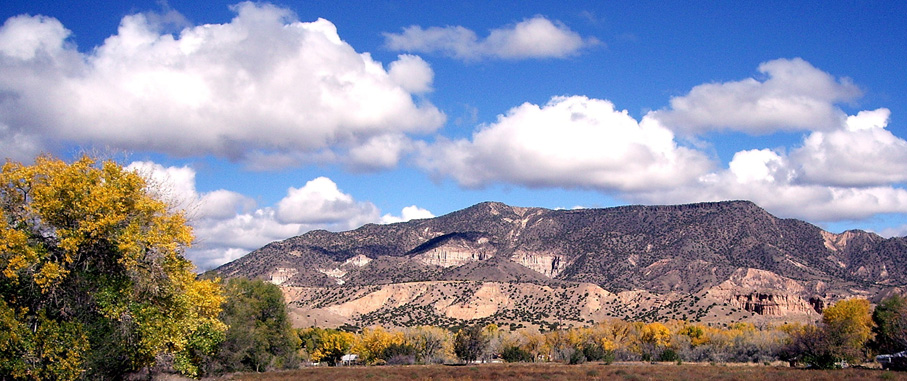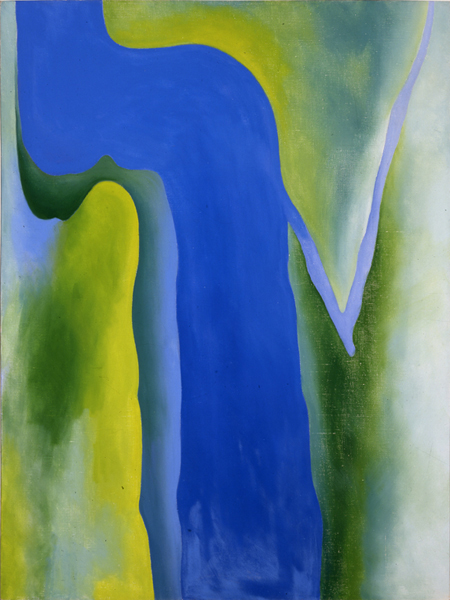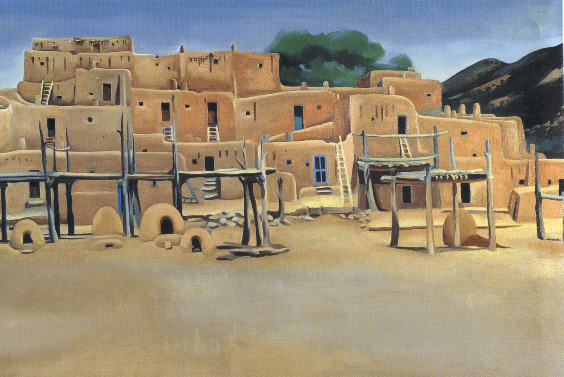
“The openness. The dry landscape. The beauty of that world.”
Georgia O'keeffe, on Texas 1900s.
The phonographically series Equivalents (1922-1935) was Stieglitz response to Georgia O'keeffe's leaving him for New Mexico in the 1930s
About O'keeffe
"Georgia was attentive to every aspect of the environment, and food was an important part of her world.”
510
“She would hold out a rock and ask ‘What do you see?’ “ She challenged and encouraged the children… to complete their education.”
(A remembrance of Vidal Martinez of Abiquiu)
p. 488.
 In the late 1950s, O’keeffe began the “Rivers Seen from Air”
series first in charcoal then in paint. These meandering silhouettes against
murky backgrounds are vague and
undefined, and have little power compared with her great series.
In the late 1950s, O’keeffe began the “Rivers Seen from Air”
series first in charcoal then in paint. These meandering silhouettes against
murky backgrounds are vague and
undefined, and have little power compared with her great series.
496.
“Her paintings from the air, both of the air and the earth, lack the tension and power that derive from the contrast of the two elements.”
496
“There were people on the plains who embraced the sky, the weather, and the landscape as exultantly, as Georgia did; this was more important to her than conversation.”
169
“Georgia could create her own intellectual landscape, though this was not always satisfactory….Still, the physical landscape—the wide beauty—was the necessary one. On the plains she felt herself vividly alive and surrounded by a vivid life: the pictures from this period reflect this intensity with a corresponding brilliance.”
170
“but he likes living.” Of an old farmer/ex schoolteacher with whom she hitched onto and was given a ride home.
Her trip to Mexico to see Siqueros, Kalo and Diego Rivera’s works.
490
“Some time around 1971 she began to lose her central vision.
 Taos Pueblo.
Taos Pueblo.
“When I began working at it, I found that I wasn’t seeing . . . things were beginning to be dull for me.”
“My world is blurred.” O’Keeffe told her friend Peggy Kiskadden
422
Macular degeneration
“most people depend on sight to make order of their lives.” RR,
514
“Now (at 81) color had become uncertain, and line was gone almost altogether.”
She could no longer see the Pedernal Mountains at Abiquiu
Georgia O'keeffe “but I know it is there.”
Back of the envelope writing:
“ I saw the crosses so often—and often in unexpected places—like a thin dark veil of the Catholic Church spread out over the New Mexican landscape.”
516
A beginning
In Texas Panhandle, 20 miles south of Amarillo- Canyon, Texas, August, 1916,
To teach at West Texas State Normal College, forty-acre tract, dedicated in 1910.
“You know this was open country…sometimes when there was large herds brought in around town some cattle would die and…those carcasses… ‘I'd just lie there and bleach out. I remember she brought a skull in and leg bones and told us how beautiful they were—the sheen on those dried bones, and the look of those bones.”
160
“Tonight I walked into the sunset . . .the whole sky –and there is so much of it out here—was just blazing—and grey-blue clouds were rioting all through the hotness of it…”
The Eastern sky was all grey-blue –bunches of clouds different kinds of clouds—sticking around everywhere and the whole thing lit up—first in one place—then in another with flashes of lightning with a sharp bright zigzag flashing across it.
161
“Walked out – and sat on the fence for a long time—just looking at the lightning—you see there was nothing but sky and flat prairie land.—land that seems more like the ocean than anything else I know.”
“It is absurd the way I love this country. . . and the sky – You have never seen sky—it is wonderful.”
161
12 miles from us was Palo Duro Canyon “Opening suddenly in the wide dark plains.”
161-162
Alfred Stieglitz sent her a copy of Faust in , 1916, and she wrote “its simply great. . . I almost lost my mind the day I started reading it.”
169
“The experience was always worth the risk.”
“Scared to death. But I never let it stop me. Never.”
166
Georgia O’Keeffe: A Life, Hanover; Lebanon, N. H.: University Press of New England, 1989.


